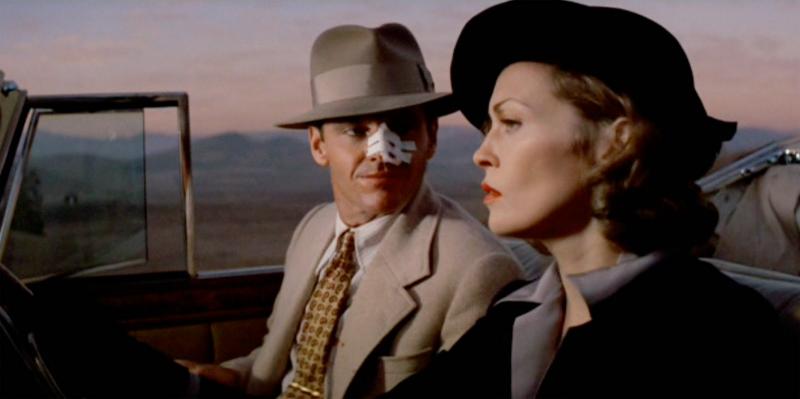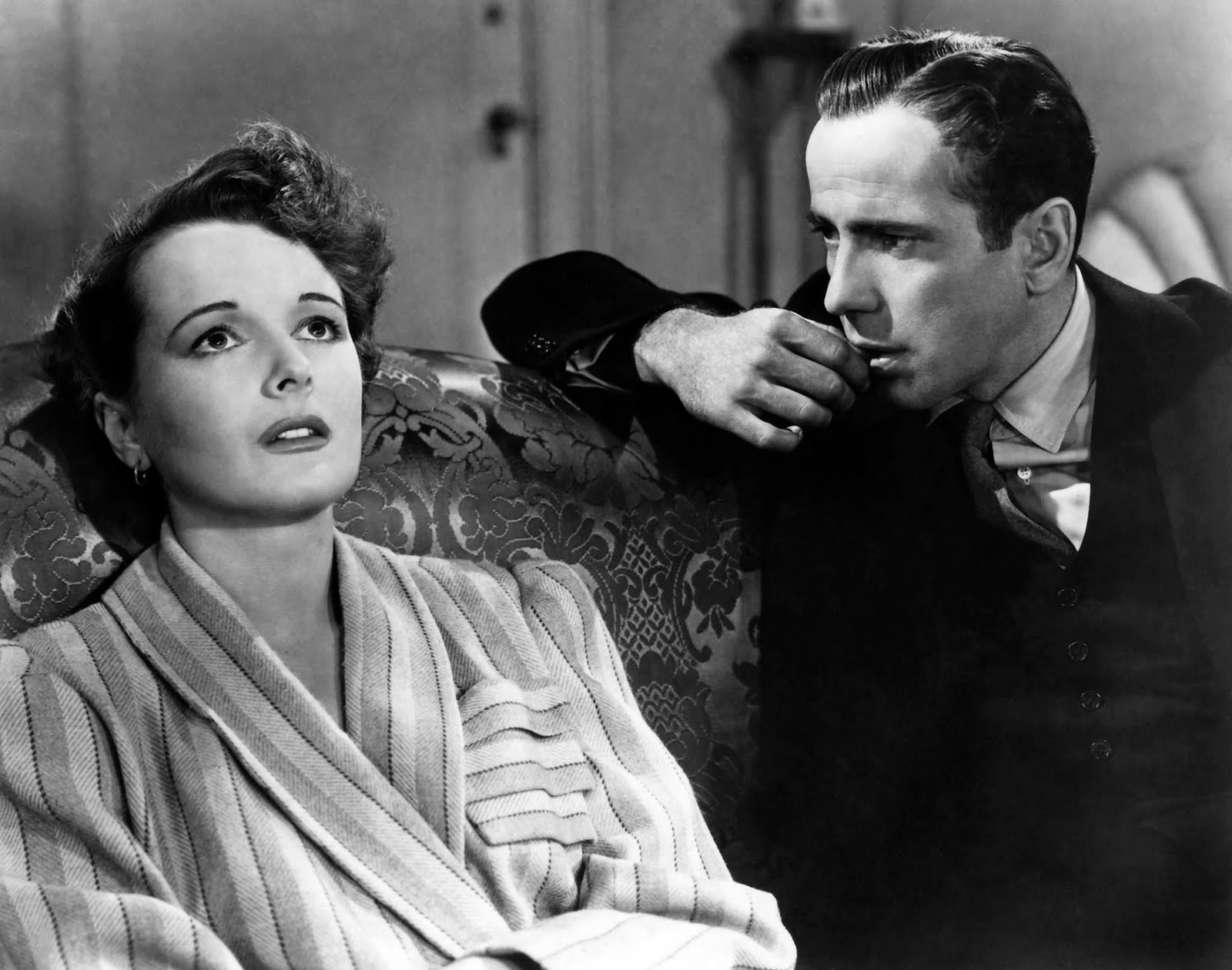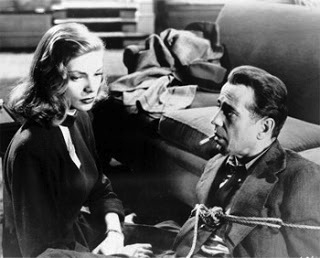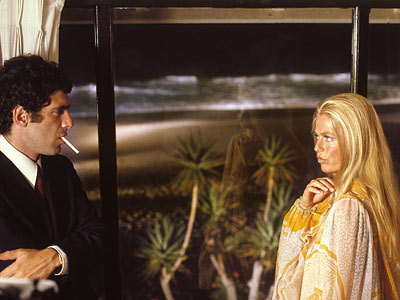"Forget it, Marlowe - it's Chinatown" | reviews, news & interviews
"Forget it, Marlowe - it's Chinatown"
"Forget it, Marlowe - it's Chinatown"
How Roman Polanski's masterpiece demythologised the hard-boiled private eye

The movie version of the hardboiled, trenchcoated private eye, who, being “being neither tarnished nor afraid,” puts honour before personal gain in California’s 1940s noir cityscapes, was never as enduring as his literary original.
The re-release of Roman Polanski’s 1974 Chinatown (which is being showcased at BFI Southbank throughout January) reminds us that the myth consecrated by Humphrey Bogart, as Sam Spade in John Huston's The Maltese Falcon (1941), and as Philip Marlowe in Howard Hawks's The Big Sleep (1946), was not an endlessly renewable resource. Once Jack Nicholson had played Jake Gittes in Polanski’s masterpiece and again in the convoluted (yet involving) The Two Jakes (1990), which Nicholson himself directed, Dashiell Hammett’s Spade and Raymond Chandler’s Marlowe were regrettably consigned to obsolescence.(Pictured below right: Mary Astor and Bogart in The Maltese Falcon)
 Actually, Marlowe has returned once since The Two Jakes. James Caan put on a brave face as an older married Marlowe in Bob Rafelson’s 1998 HBO film Poodle Springs, which was adapted from the unfinished Chandler novel badly completed by Robert B. Parker in 1989. The same author erred again with Perchance to Dream, his 1991 sequel to The Big Sleep, the first Marlowe novel.
Actually, Marlowe has returned once since The Two Jakes. James Caan put on a brave face as an older married Marlowe in Bob Rafelson’s 1998 HBO film Poodle Springs, which was adapted from the unfinished Chandler novel badly completed by Robert B. Parker in 1989. The same author erred again with Perchance to Dream, his 1991 sequel to The Big Sleep, the first Marlowe novel.
The announcement last August that John Banville had been authorized by the Chandler estate to write (under his nom de crime Benjamin Black) a new Marlowe novel was cheering news for all Marlovians as Banville could well succeed where Parker failed. If so, it would inevitably prompt talk of a movie; perhaps it would star Clive Owen, who, as of 2007, was to have played Marlowe in a Frank Miller adaptation of Chandler’s Trouble Is My Business but instead will reprise the Marlowe derivative Dwight McCarthy in Miller and Robert Rodriguez’s upcoming Sin City sequel.
Whereas Marlowe’s existential plight as a terminal outsider-idealist in a filthy, corrupt world means he can survive indefinitely on the page, the transformation of film noir in the 1950s and again in the 1970s militated against the resurrection of a protagonist whose heyday was during and after World War II. Far from invulnerable, Marlowe doggedly stuck to his principles and dredged for the truth in the human cesspool in three powerful films: Edward Dymtryk’s expressionistic Murder, My Sweet (1944, adapted from Farewell, My Lovely), the screwball-tinged The Big Sleep – the definitive Marlowe movie – and Robert Montgomery’s experimental Lady in the Lake (1947). Though it is filled with shadows and threat, John Brahm’s literal-minded The Brasher Doubloon (1947, from The High Window) showed no appreciation for Chandler’s grubby romanticism.
The emergence of widescreen and increased colour cinematography in the 1950s ruptured the private eye’s claustrophobic, black and white world. The last two great noirs of the classic era (which were shot in black and white) exposed the fallacy of the honorable detective. Robert Aldrich’s Kiss Me Deadly (1955) introduced Mickey Spillane’s brutal divorce dick Mike Hammer (Ralph Meeker) as a fascistic purgative, his upward mobility auguring that of Gittes. (Pictured below left: Bacall and Bogart in The Big Sleep)
 In Orson Welles’s Touch of Evil (1957), Welles’s Hank Quinlan is a mouldering, obese police captain who has the aura of a private eye. A planter of evidence who stoops eventually to murder, he has become bloated with corruption, but in Quinlan’s eyes the end justifies the means and his record has made him a legend on the Mexican border. The long-ago killing of the wife for whom he still grieves makes him a sympathetic character, and his death in the trash-strewn river is tragic. The epitaph for him spoken by Marlene Dietrich’s madame – who allows that he was “a lousy cop” but “some kind of a man. What does it matter what you say about people?” – was also an epitaph for an obsolete code of behaviour and for film noir itself.
In Orson Welles’s Touch of Evil (1957), Welles’s Hank Quinlan is a mouldering, obese police captain who has the aura of a private eye. A planter of evidence who stoops eventually to murder, he has become bloated with corruption, but in Quinlan’s eyes the end justifies the means and his record has made him a legend on the Mexican border. The long-ago killing of the wife for whom he still grieves makes him a sympathetic character, and his death in the trash-strewn river is tragic. The epitaph for him spoken by Marlene Dietrich’s madame – who allows that he was “a lousy cop” but “some kind of a man. What does it matter what you say about people?” – was also an epitaph for an obsolete code of behaviour and for film noir itself.
Robert Towne wrote Chinatown as a lament for the Los Angeles he had loved growing up but that had shucked off its romance and was changing again for the worse in the 1970s. Polanski filmed it in what Neil Sinyard has described as "poisonous colour" and in Panavision. It is as beautiful and serpentine as a Brazilian Rainbow Boa, and as sickening.
Although the movie’s narrative is Chandlerian in its procession of incidents, Towne knew Gittes would be a joke if he were like Marlowe. So he made him a detective whose values and practices were, initially at least, more self-seeking than his knight-errant predecessor. Gittes is a flash, oily clotheshorse who has made a success of himself doing divorce work – as a bedroom peeper – which Marlowe, of course, wouldn’t touch. Unike Marlowe, he’s also a vulgarian and an inept wit: the racist sex joke he tells his two operatives indicate his crassness and embarrasses him in front of Evelyn Mulwray (Faye Dunaway) when she and her lawyer enter the room behind him. Even when he and Evelyn become close, he lapses into crudities.
By the time of The Two Jakes – set in 1948, 11 years after Chinatown – Gittes has become a much-publicized successful businessman, one aware of his reputation as a pariah: “In this town, I’m the leper with the most fingers he says.” His traumatising experiences in 1937 mellowed him and he is less slimy, but the boorishness remains. “Honestly, I'm trying to be a gentleman about this,” he wearily instructs the very eager Lillian Bodine (Madeleine Stowe) in his office. “Now just get down on your knees. Down on your knees. Stick your ass up in the air and don't move until I tell you.”
Even Bogart’s cruel Spade, who screwed his hated partner’s wife before falling into a love affair with the femme fatale Brigid O’Shaughnessy (Mary Astor) wouldn’t have said that – not on screen in 1941 – though he might have thought it. Chandler’s Marlowe also expressed his virility, favouring “smooth shiny girls, hard-boiled and loaded with sin,” but he never took advantage of weak, neurotic, or depraved women. Bogart’s Marlowe immediately sees that Carmen Sternwood (Martha Vickers) is an unstable nymphomaniac, opting instead to woo her self-assured older sister, Vivian (Lauren Bacall).
Chinatown wasn’t the first post-modern film to revise the private eye myth
The chief distinction between Bogart’s private eyes and Gittes, however, is the latter’s ineffectivess. Spade and Marlowe will not yield: Spade turns in the murderous Brigid for killing his partner, even though he loves her; Marlowe protects the Sternwood sisters and provokes the killing of the gangster Eddie Mars. First hired by a woman (Diane Ladd) purporting to be Evelyn, Gittes stumbles through his case and gets his nose slit for his troubles (Polanski's pint-sized thug delivering the symbolic castration).
In the end, Gittes proves powerless to prevent the demonic robber baron Noah Cross (iconically played by Huston) from extending his control of the Los Angeles water supply and unlawfully speculating in cheap land in the San Fernando Valley, which will become profitable when Cross has masterminded the building of an unsafe dam. (Evelyn’s murdered husband, William Mulwray, and aspects of Cross were inspired by William Mulholland, who had built Los Angeles’ water infrastructure and, in 1928, had supervised the building of a dam forty miles north of the city, which had collapsed, killing some 600 people; Cross is an amalgam of such dominant city fathers as Fred Eaton, J.R. Lippincott, and Harrison Otis.)
Gittes does discover a chivalrous side before the end, but his moral awakening amounts to a sandcastle facing a tidal wave of greed, corruption, and evil. Having become Evelyn’s lover and discovered the nature of the crime that Cross, her father, has perpetrated against her, Gittes is not only unable to stop him furthering his rape of his family, but unwittingly facilitates it. He had similarly endangered a woman he’d cared for years before when working for the D.A. in Chinatown, the movie’s metaphoric heart of darkness, where it comes to its terrible climax – a climax that Polanski, with Watergate and the 1970s’ pervasive paranoia in mind, had insisted on against Towne’s wishes. "Forget it, Jake," Gittes is told as he's led away at the end. "it's Chinatown."
Watch that scene from Chinatown
Chinatown wasn’t the first post-modern film to revise the private eye myth. In Robert Altman’s 1973 The Long Goodbye, Elliott Gould played Marlowe as a shabby, inarticulate cynic hopelessly out of time – Altman described him as “Rip Van Marlowe” – in hippie-era L.A; the film was written by Leigh Brackett, who had contributed to the screenplay of Hawks’s The Big Sleep. Like Gittes, Gould’s Marlowe is played for a sucker from the off. He drives his old friend Terry Lennox (Jim Bouton) out of harm’s way to Tijuana and is then hired by Eileen Wade (Nina Van Pallandt) to locate her alcoholic husband, the novelist Roger Wade (Sterling Hayden, channeling Hemingway). Wade drowns himself thinking he had killed Lennox’s wife, with whom he was sleeping, during a binge. (Pictured below: Elliott Gould and Nina Van Pallandt in The Long Goodbye)
 Only when Marlowe discovered Lennox killed his wife and that Lennox and Eileen are a duplicitous couple does he take action – the kind that Chandler's original would never have taken. Like Bogart’s Spade and Marlowe, and even Gittes, Gould’s Marlowe has a reserve of integrity, but – no matter how often he mutters, “It’s all right with me” – he is a loser with no viable future. So, too, are Gene Hackman’s paranoid surveillance man Harry Caul in Francis Ford Coppola’s The Conversation (1974) and his beaten-down L.A. private eye Harry Moseby in Arthur Penn’s Night Moves (1975): they were the impotent spawn of the age of Watergate.
Only when Marlowe discovered Lennox killed his wife and that Lennox and Eileen are a duplicitous couple does he take action – the kind that Chandler's original would never have taken. Like Bogart’s Spade and Marlowe, and even Gittes, Gould’s Marlowe has a reserve of integrity, but – no matter how often he mutters, “It’s all right with me” – he is a loser with no viable future. So, too, are Gene Hackman’s paranoid surveillance man Harry Caul in Francis Ford Coppola’s The Conversation (1974) and his beaten-down L.A. private eye Harry Moseby in Arthur Penn’s Night Moves (1975): they were the impotent spawn of the age of Watergate.
Those who saw The Long Goodbye and Chinatown when they were first released must have questioned the straight-facedness of Dick Richard’s 1975 retro-noir Farewell, My Lovely, starring Robert Mitchum, who plays Marlowe as if his Jeff Bailey in Out of the Past (1947) had grown old instead of dying. Like Gould’s Marlowe, Mitchum’s more traditionalist incarnation shockingly turns executioner. But whereas Marlowe in The Long Goodbye shoots Lennox, Marlowe in Farewell, My Lovely shoots a woman – his client, the lethal seductress Helen Grayle/Velma (Charlotte Rampling). Notwithstanding that Mitchum would play Marlowe in Michael Winner’s unspeakable 1978 The Big Sleep remake and that Caan would do his best, Farewell, My Lovely really was the end of the knight in dark armour in the 20th century.
It was up to Gittes to restore the knightly myth once again. When, at the end of The Two Jakes, Katherine Mulwray (Meg Tilly), the damaged child-woman he has pledged to protect, kisses him on the mouth, he pulls away, becoming, finally, “a gentleman” for real.
Share this article
The future of Arts Journalism
You can stop theartsdesk.com closing!
We urgently need financing to survive. Our fundraising drive has thus far raised £49,000 but we need to reach £100,000 or we will be forced to close. Please contribute here: https://gofund.me/c3f6033d
And if you can forward this information to anyone who might assist, we’d be grateful.

Subscribe to theartsdesk.com
Thank you for continuing to read our work on theartsdesk.com. For unlimited access to every article in its entirety, including our archive of more than 15,000 pieces, we're asking for £5 per month or £40 per year. We feel it's a very good deal, and hope you do too.
To take a subscription now simply click here.
And if you're looking for that extra gift for a friend or family member, why not treat them to a theartsdesk.com gift subscription?
more Film
 Honey Don’t! review - film noir in the bright sun
A Coen brother with a blood-simple gumshoe caper
Honey Don’t! review - film noir in the bright sun
A Coen brother with a blood-simple gumshoe caper
 The Courageous review - Ophélia Kolb excels as a single mother on the edge
Jasmin Gordon's directorial debut features strong performances but leaves too much unexplained
The Courageous review - Ophélia Kolb excels as a single mother on the edge
Jasmin Gordon's directorial debut features strong performances but leaves too much unexplained
 Blu-ray: The Graduate
Post #MeToo, can Mike Nichols' second feature still lay claim to Classic Film status?
Blu-ray: The Graduate
Post #MeToo, can Mike Nichols' second feature still lay claim to Classic Film status?
 Little Trouble Girls review - masterful debut breathes new life into a girl's sexual awakening
Urska Dukic's study of a confused Catholic teenager is exquisitely realised
Little Trouble Girls review - masterful debut breathes new life into a girl's sexual awakening
Urska Dukic's study of a confused Catholic teenager is exquisitely realised
 Young Mothers review - the Dardennes explore teenage motherhood in compelling drama
Life after birth: five young mothers in Liège struggle to provide for their babies
Young Mothers review - the Dardennes explore teenage motherhood in compelling drama
Life after birth: five young mothers in Liège struggle to provide for their babies
 Blu-ray: Finis Terrae
Bleak but compelling semi-documentary, filmed on location in Brittany
Blu-ray: Finis Terrae
Bleak but compelling semi-documentary, filmed on location in Brittany
 Oslo Stories Trilogy: Sex review - sexual identity slips, hurts and heals
A quietly visionary series concludes with two chimney sweeps' awkward sexual liberation
Oslo Stories Trilogy: Sex review - sexual identity slips, hurts and heals
A quietly visionary series concludes with two chimney sweeps' awkward sexual liberation
 Sorry, Baby review - the healing power of friendship in the aftermath of sexual assault
Eva Victor writes, directs and stars in their endearing debut feature
Sorry, Baby review - the healing power of friendship in the aftermath of sexual assault
Eva Victor writes, directs and stars in their endearing debut feature
 Blu-ray: Who Wants to Kill Jessie?
Fast-paced and visually inventive Czech comedy
Blu-ray: Who Wants to Kill Jessie?
Fast-paced and visually inventive Czech comedy
 Oslo Stories Trilogy: Love review - freed love
Gay cruising offers straight female lessons in a heady ode to urban connection
Oslo Stories Trilogy: Love review - freed love
Gay cruising offers straight female lessons in a heady ode to urban connection
 Beating Hearts review - kiss kiss, slam slam
Romance and clobberings in a so-so French melodrama
Beating Hearts review - kiss kiss, slam slam
Romance and clobberings in a so-so French melodrama

Add comment